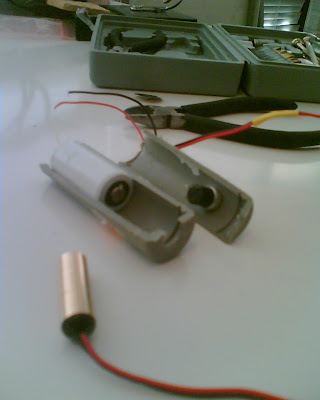First week in the plan has now passed, and we are basicly one week behind :)
Well, I will admit that the plan was very optimistic, but sometimes we are just to dumb. We still have problems finding the intersection of horizontal and vertical lines, although this should be a very simple problem, we still have problems regarding, I guess, the aspect ratio... As we are using linear parametric hough transform, we cannot describe vertical lines.
We suspect that the trouble arise from using hough transform two times on the same image, one time for horizontal, and one time for vertical, simply by flipping the x and y coordinates.
The coordinates are normalized to [-1:1[ on both axises, everything should really be fine.
The problem is that the slope of the vertical lines are... drifting... I don't know how to better explain it, with a single word, but with multiple; when the lines are exactly vertical, the lines are also, then as the angle of the line changes, the distance to the real lines increases.
Any ideas ? solutions, don't hesitate to leave a pointer of what can go wrong here.
Outr sollution is probably to change to a generic hough transform, where we use the angle of the line and distance, wikipedia description here. And ultimately, if we cant get our own to work, use the one in openCV.
I will, right now, work on making some openGL application where we can visualize the calibration object, the laser plane and the 3Dpoints when we at some point in the future have a working linedetection etc.
19 October 2007
16 October 2007
Line detection - using hough transform 2

Ok, so it didn't work that well, but it seems like it is working now, also with real points.
The subproblem of disallowing the same peak in the hough-space to create multiple lines was solved by maskin out the area such that we are sure there is some minimum distance betwen the lines ( that is distancebetween the a and b parameters )
The two images shows, first the laser line on a dark image, and second the lines detected on a thresholded image.

14 October 2007
Line detection - using hough transform
It is done, the detection works. At least whit simulated points, but why wouldn't it work with real problems :)
There are still some sub-problems whith the line detection which must be solved, shuch as, we wan't 2 lines ( one laser line hitting a 90 degree corner) , and we must be sure that we select the correct
13 October 2007
Week one - a few dayes in the schedule
Ok, now we have finally worked out a time schedule for what and when regarding the development.
I don't have the plan, so I cannot show it (u9 upload?) .
For this week (saturday now) we are finishing a laser line detection algorithm, and perhaps a calibration pattern corner detection algorithm.
The laser line detection is using a thresholded grayscale image, tranformed into a parametric hough space, hopefully tomorrow some images of this are ready.
I don't have the plan, so I cannot show it (u9 upload?) .
For this week (saturday now) we are finishing a laser line detection algorithm, and perhaps a calibration pattern corner detection algorithm.
The laser line detection is using a thresholded grayscale image, tranformed into a parametric hough space, hopefully tomorrow some images of this are ready.
06 October 2007
The "lasors" :)
Ofcourse, when one recieves a laser line generating device, it is one's finest duty to document this posetion :).
In the following some images of the wonder.

A hand and a laser.

Me happy whith the laser.

U9 whith the laser. Yes, that is his happy face.

A handheld laser contraption before comletion.
The housing is a battery shell, which besides from being big, housed the smaller 3v battery, the white thingy also in the foto. As you might can see, there is not much room to the wire and switch.

A very crude fully functional handheld laser contraption. Erhm work on a more... mainstream look are being caried out.
In the following some images of the wonder.

A hand and a laser.

Me happy whith the laser.

U9 whith the laser. Yes, that is his happy face.

A handheld laser contraption before comletion.
The housing is a battery shell, which besides from being big, housed the smaller 3v battery, the white thingy also in the foto. As you might can see, there is not much room to the wire and switch.

A very crude fully functional handheld laser contraption. Erhm work on a more... mainstream look are being caried out.
04 October 2007
Let There Be Light
This is the first post.
We concluded after the first group meeting that we will in fact do the 3D reconstruction of objects using a laser scanner and camera. Hence the name of the blog.
This blog will be our diary during the course of the semester.
This first day we received two World Star Tech FLL series red laser line modules (fll5-3.5p-635-**) which emit a red thin line that we will use to construct 3D models of arbitrary shaped objects. We quickly gathered some components from the component shop (battery, wired and push-buttons) and created a nice hand-held scanning device.
(images coming)
We concluded after the first group meeting that we will in fact do the 3D reconstruction of objects using a laser scanner and camera. Hence the name of the blog.
This blog will be our diary during the course of the semester.
This first day we received two World Star Tech FLL series red laser line modules (fll5-3.5p-635-**) which emit a red thin line that we will use to construct 3D models of arbitrary shaped objects. We quickly gathered some components from the component shop (battery, wired and push-buttons) and created a nice hand-held scanning device.
(images coming)
Subscribe to:
Comments (Atom)